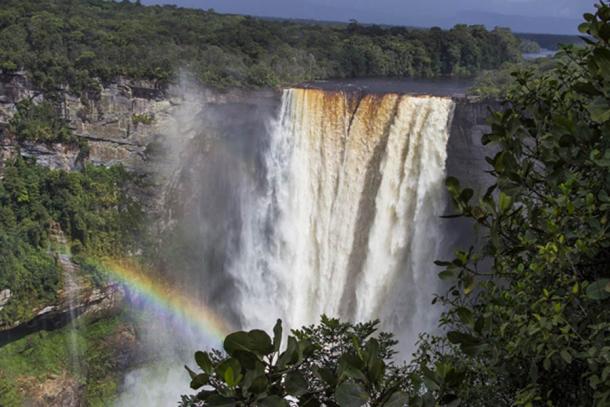Auburn waves falling into cascading rainbows, the Kaieteur Falls radiate both mist and magic. Among the lesser known worldwide waterfalls, Kaieteur Falls are interestingly one of the most sought after experiences by adventure hikers and nature enthusiasts. With an obscure history imbued as much by mystery as the waves themselves are by lore, the Kaieteur Falls are certainly a sight worthy of any adventurer’s bucket list.

Kaieteur Falls . ( homocosmicos /Adobe Stock)
Where is Kaieteur Falls?
Located in the branch of the Amazon rainforest in Guyana’s Potaro-Siparuni region, Kaieteur Falls is revered as one of the most impressive single-drop waterfalls. (The term “single-drop” merely indicates that the waterfall has one vertical fall of water.) Kaieteur Falls is one of only a few single-drop waterfalls.
Rivaling the far better-known Niagara Falls, Kaieteur Falls looms “four times taller” than the New York-Canadian waterfall, with a “wide, coffee colored flow” adding to its already unique facade.
Kaieteur Falls, estimating to stand at almost 750 feet (228.6 meters) high, is made of natural sandstone, and the feature is under examination to determine whether it is, in fact, the tallest single-drop waterfall in the world. If so, Kaieteur Falls certainly deserves much more publicity than it currently claims.

Kaieteur Falls located in Guyana (Potaro River, Kaieteur national park, South America). ( Gornyakova /Adobe Stock)
The Legends and Lore of Kaieteur Falls
As with most places with an appearance that could have been carved from a fairy tale, the history of Kaieteur Falls is richly adorned with legends and lore. One of the more prominent tales of its existence is the pseudo-historical story of its name.
First “discovered” by Charles Barrington Brown on April 24, 1870, Kaieteur Falls was introduced to those outside its immediate region in the 19th century. Much of the aforementioned lore has been passed down through Brown, and there is thus likely more to the Kaieteur folklore than is currently known. A debt of gratitude is owed to Brown, however, for recording what he did from the natives.
Hero or Betrayer?
In a well-detailed review from Wondermondo’s travel blog, the Falls’ historical-mythological history, as dictated to Brown during his investigations, is cleverly described:
“… Kaieteur Falls was said to be named after an Amerindian chief by the name of “Kai” who gave his life by canoeing over the falls. Apparently, he did this in order to protect his tribe from a rival Carib tribe by means of divine intervention…The word ‘teur’ meant falls in the native Amerindian language so technically it would be redundant to include the word “Falls” in Kaieteur.”
Chief Kai’s act of self-sacrifice to the spirit Makonaima apparently saved his people.
The second tale of Kaieteur Falls is much more disturbing—instead glorifying a chief, it remembers the betrayal of an innocent old man:
“Once upon a time there lived an old Indian at a village above the fall, an exceedingly feeble old man, whose feet became infested with chigoa fleas to such an extent that he gave his friends and relatives an immense amount of trouble in picking them out for him every morning.
So, they determined to rid themselves of the nuisance, and accordingly placed the old man in a woodskin just above the edge of the fall, and shoved it out into the stream. The strong current hurried him to the brink and swept him over its foaming water, and he was seen no more.”(from C. B. Brown via Wondermondo)

Kaieteur Falls, Guyana. (DreanA /Adobe Stock)
Kaieteur Falls and the Patamona Tribe
The Amerindian tribe (more appropriately referred to as a Pre-Columbian or indigenous tribe) likely responsible for sharing these legends with Brown—and therefore possibly the naming of the Falls themselves—are thought to be the Patamona Tribe (sometimes spelled Patamuna).
This tribe has roots in the same region of Guyana in which the Kaieteur Falls are located, specifically near the upper portion of the Siparuni River, a tributary feeding the larger Essequibo River in parts of Guyana, Venezuela, and Brazil, among other areas.

People in the Patamona tribe on the Kaieteur Plateau. ( Public Domain )
The Patamona culture is known best from their surviving artifacts; however, remnants of their culture survive in Paramakatoi, a village currently located in the same region of Kaieteur Falls. The Patamona culture is recognizable in this village through its linguistic associations with the Cariban language, the umbrella language of various indigenous people of Guyana. (It is more common to group cultures by linguistic similarities rather than physicality in numerous cultures, not merely Pre-Columbian societies.)
Though it appears that the immediate area surrounding Kaieteur Falls is devoid of civilization, it is not implausible to presume that the area in the Falls’ vicinity was once rich with culture. Should adventurers or archaeologists one day discover the lore of Kaieteur’s name to be accurate, perhaps those who named the waterfall will come to light as well.
Until that day, however, Kaieteur Falls’ history will remain just out of reach; yet the magical experience of the sight is within everyone’s grasp.

Kaieteur waterfall, one of the tallest falls in the world at Potaro river Guyana . ( homocosmicos /Adobe Stock)
Top Image: Kaieteur Falls, Guyana. Source: DreanA /Adobe Stock
Updated on April 15, 2021.
Related posts:
Views: 0
 RSS Feed
RSS Feed
















 April 16th, 2021
April 16th, 2021  Awake Goy
Awake Goy  Posted in
Posted in  Tags:
Tags: 
















